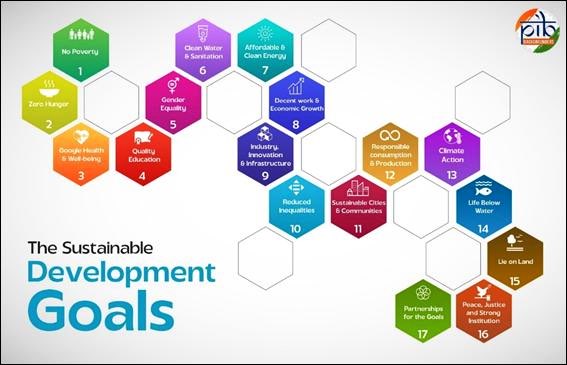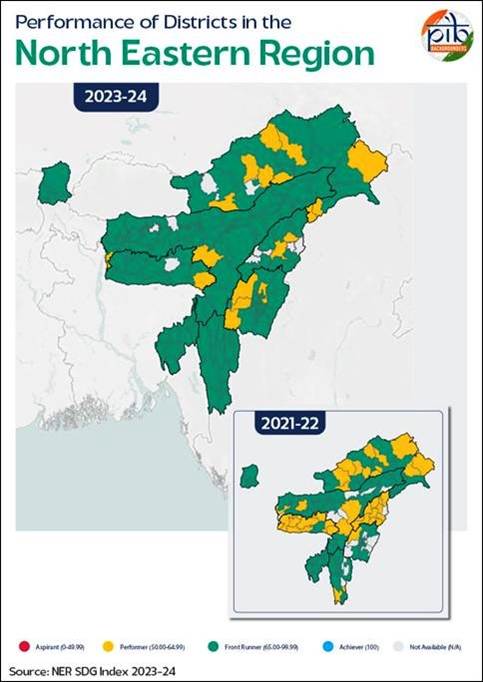Content :
- North East India’s SDG Progress (2023–24)
- A Decade of Building Skills & Empowering Dreams
North East India’s SDG Progress (2023–24)
Overview & Coverage
- 121 out of 131 NE districts assessed — expanded from 103 (2021–22).
- Tracks 15 out of 17 SDGs using 84 indicators (41 from central, 43 from state sources).
- SDG 11 included only for 79 urban districts; SDG 14 excluded; SDG 17 minimally relevant.
- Classification:
- Achiever (Score = 100)
- Front Runner (65–99.99)
- Performer (50–64.99)
- Aspirant (<50)
Relevance : GS 2(Governance)
Key Outcomes
- 103 districts (85%) are now Front Runners (vs 62% in 2021–22).
- Top Scoring District: Hnahthial (Mizoram) – 81.43
- All districts in Mizoram, Sikkim, and Tripura are Front Runners.
SDG-Wise Progress (2021–22 → 2023–24)

| SDG | Goal | Front Runners | Aspirants | Key Insights |
| 1 | No Poverty | 21 → 36 | 20 → 3 | Targeted poverty schemes impactful |
| 2 | Zero Hunger | 49 → 83 | 21 → 1 | Nutrition missions gaining ground |
| 3 | Health & Well-being | 14 → 48 | 18 → 6 | Better access & infrastructure |
| 4 | Quality Education | 36 → 80 | – | Education-focused schemes succeeding |
| 5 | Gender Equality | 71 → 112 | 1 | One of strongest performing goals |
| 6 | Water & Sanitation | 81 → 114 | – | Driven by Jal Jeevan & Swachh Bharat |
| 7 | Clean Energy | 7 → 14 (Achievers) | – | LPG & electrification improving access |
| 8 | Decent Work | 69 → 111 | – | Economic activity expanding |
| 9 | Infrastructure | 55 → 92 | – | Road, connectivity improved |
| 10 | Inequality | 59 → 43 | 12 → 33 | Major concern – rising gaps |
| 12 | Consumption | 67 → 51 | 18 steady | Calls for sustainability awareness |
| 13 | Climate Action | 36 → 59 | 49 | Weakest performing area |
| 15 | Life on Land | 12 → 26 (Achievers) | – | Forest & biodiversity gains |
| 16 | Justice & Institutions | 64 → 90 | 1 → 5 | Governance improving but mixed |
Top 10 Performing Districts (NER)
- Mizoram: Hnahthial, Champhai, Kolasib
- Tripura: Gomati, West Tripura, South Tripura
- Nagaland: Mokokchung, Kohima, Dimapur
- Sikkim: Gangtok

State-wise Highlights
- Mizoram
- 100% districts Front Runners
- Best: Hnahthial (NER’s highest score)
- Strong in SDGs 5, 6, 7, 8, 9, 15, 16
- Sikkim
- All 6 districts Front Runners
- Smallest intra-state gap (5.5 pts)
- Best: Gangtok | Balanced across SDGs
- Tripura
- All 8 districts Front Runners
- Top: Gomati | Strong across 9 SDGs
- Low disparity (6.5 pts between best-worst)
- Nagaland
- 9 of 11 districts Front Runners
- Wide performance gap (15.07 pts)
- Strong in SDGs 2, 5, 6, 8, 11, 13, 15
- Assam
- 89% districts are Front Runners
- Best: Dibrugarh | Needs work in justice systems
- Arunachal Pradesh
- Only 59% Front Runners
- Best: Lower Dibang Valley | Worst: Longding (NER’s lowest score – 58.71)
- Challenges in SDGs 9, 13
- Manipur
- 75% Front Runners
- Top: Imphal West | Weak in SDG 10 (Inequality)
- Meghalaya
- 84% Front Runners
- Top: East Khasi Hills | Weak in Education (SDG 4)
Key Takeaways
- High Performers: Health, Education, Water, Gender Equality, Economic Growth.
- Lagging Areas: Climate Action (SDG 13), Inequality (SDG 10), Responsible Consumption (SDG 12).
- Flagship Schemes: Jal Jeevan Mission, Swachh Bharat, Aspirational Districts Programme contributed strongly.
- Disparities Persist:
- Nagaland: 15.07 pt gap between best-worst districts
- Sikkim & Tripura: Least disparities, highest uniformity
Governance & Systemic Impact
- Data Systems: Significant improvements in district-level data reporting.
- Localisation: Strong correlation between state-driven planning and SDG performance.
- Peer Learning: Index fosters competitive federalism & inter-district collaboration.
Conclusion
- The NER SDG Index 2023–24 marks major progress in NE India’s sustainable development landscape.
- 85% of districts now Front Runners, up from 62% in 2021–22.
- Balanced progress across most SDGs, but climate resilience and inequality remain critical challenges.
- The Index stands out as a planning, performance, and policy tool — not just a ranking mechanism.
A Decade of Building Skills & Empowering Dreams
Macro Achievements (2015–2025)
- 6+ crore Indians empowered through skill development schemes since 2014.
- 1.63 crore+ candidates trained under PMKVY alone across four phases.
- Over 25 lakh candidates trained under PMKVY 4.0 (as of July 11, 2025).
- Training expanded to futuristic domains: AI, Robotics, IoT, Drones, Mechatronics.
- 45% of PMKVY trainees are women, with significant SC/ST/OBC representation.
Relevance : GS 2(Schemes , Governance)
Skill India Mission (SIM) – Structural Integration (2022–26)
- Unified under a single Central Sector Scheme approved in 2025.
- Schemes merged:
- PMKVY 4.0 (Short-term skill training & RPL)
- PM-NAPS (Apprenticeship & industry engagement)
- JSS (Literacy-focused vocational training)
- Two new Centres of Excellence set up at NSTIs (Hyderabad & Chennai) for high-quality skilling.
PMKVY: Phased Evolution & Milestones
| Phase | Year(s) | Key Milestones | Candidates Trained |
| 1.0 | 2015–16 | Pilot phase, monetary reward (₹500), free certification | 19.85 lakh |
| 2.0 | 2016–20 | Scaled across sectors/states; aligned with Make in India, Digital India | 1.10 crore |
| 3.0 | 2020–22 | Introduced: COVID Crash Courses (1.2L), Skill Hub (1.8L), Traditional craft focus | 7.37 lakh |
| 4.0 | 2022–26 | Digital reforms (SIDH), Academic Credit Transfer, Future skills | 25+ lakh (till Jul ’25) |
- STT placement rate till PMKVY 3.0: 42.8%.
PMKVY 4.0: New Features & Focus (2022–2026)
- Skill India Digital Hub (SIDH): end-to-end digital integration of skilling, employment, and entrepreneurship.
- Academic Bank of Credits: Transferable skill credits to bridge education–vocational divide.
- Rs. 1244.52 crore utilized across states/UTs by Dec 2024.
- Encourages career-oriented skilling, not just placement tracking.
Innovative & Inclusive Initiatives
- Special Projects:
- Bru-tribe training in Tripura (2,500+)
- Jail inmates in Assam, Manipur
- PANKH project: 13,834 trained (70% women)
- Traditional Skills:
- 2,243 women trained in Namda craft (J&K)
- 9,605 artisans skilled via RPL (J&K, Nagaland)
- COVID-19 Response: 1.2 lakh healthcare workers trained as COVID Warriors.
- Skill Hub Initiative: 1.23 lakh trained through school/college-based hubs (aligned with NEP 2020).
- Mainstreaming with National Missions: Skills integrated into:
- PM Surya Ghar
- Vibrant Villages Programme
- Jal Jeevan Mission
- Green Hydrogen Mission
Supporting Schemes in the Skilling Ecosystem
- Jan Shikshan Sansthan (JSS)
- Focused on non-literates, school dropouts (15–45 yrs).
- 26+ lakh trained from FY 2018–19 to 2023–24.
- Emphasis on women, SC/ST/OBC, minorities in rural & low-income urban areas.
- PM-NAPS (Apprenticeship)
- 43.47 lakh apprentices engaged as of May 2025.
- Over 51,000 establishments participating.
- PM Vishwakarma Yojana
- Launched: Sept 2023 | Budget: ₹13,000 crore
- Supports 18 traditional trades (e.g. blacksmiths, cobblers, potters).
- As of July 2025:
- 2.7 crore+ applications submitted
- 29 lakh+ registrations completed
- Deen Dayal Upadhyaya Grameen Kaushalya Yojana (DDU-GKY)
- Launched: 2014 | Target: rural youth
- Till Nov 2024:
- 16.9 lakh trained
- 10.97 lakh placed (~65% placement)
- Rural Self Employment & Training Institutes (RSETIs)
- Bank-led residential entrepreneurial training.
- Candidates trained:
- 2016–17: 22.89 lakh2025–26 (till Jun): 56.69 lakh
Thematic Impact
| Focus Area | Progress |
| Inclusivity | 45% women; large SC/ST/OBC share |
| Sectoral Spread | Manufacturing, construction, IT, healthcare, retail, crafts |
| Rural Reach | Skilling penetrated remote regions |
| Future Skills | AI, IoT, Robotics, Drones, Green Hydrogen |
| Digital Governance | Aadhaar-linked validation, performance-based payments |
| Academic Integration | Credit-based skilling via ABC |
Conclusion
- PMKVY = Backbone of India’s short-term skilling ecosystem over the past decade.
- Transformed from placement-linked certification to flexible, future-ready career empowerment.
- Integrated with national missions, NEP 2020, and digital governance frameworks.
- PMKVY stands as a cornerstone of Atmanirbhar Bharat and Viksit Bharat, ensuring India’s youth are not only employable, but also entrepreneurial and globally competitive.



